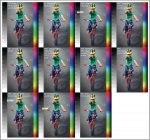OK folks...thanks to those that participated in this exercise. I hope you all have a prediction as to the result.
Please see attached screen grab - it shows the result in a small enough file format for this test.
Only one image actually looked different than the others (2nd row 1st image) it was visibly slightlyless saturated (which suggests that the test was valid). But the rest were effectively the same despite being from different displays, calibrated or not calibrated, and different operating systems.
IMHO this basically shows that unattended color management is more than good enough to prepare images with some degree of confidence that what I see you will see. And if your proofs look like what you see and your presswork looks like your proofs then life is good.
If I continue to see what I want to see as the image goes through page layout and PDF creation then isn't that the right way?
Is color management a mess or has it finally disappeared as some would say that it rightly should?
Or is this test totally off-base? If so in what way?
I was thinking about this and at first I wasn't sure what you were trying to do. I think you were trying to show that for some conditions, colour works well without too much colour management fuss.
Thinking more about this I was wondering if indeed you were off-base. You will have to tell me if my following comments make any sense.
OK. You post an image. We see an image. Some people copy the image with the screen grab function and send it to you and you look at the images. They tend to look the same to you.
What are images? We see something but the images are basically data. You send data, some people copy that data and send that data back to you and your system sees the images look basically the same. Why not if all the images are the same data.
We see images but there is nothing to say what we see is the same as what anyone else sees because our display devices might show the same data differently. You would need to see all the display devices side by side to determine if they look the same but I don't see how that can be done with this test.
That may be the off-base situation. I don't know for sure but it is suspicious.
I do think that now with more modern computers and displays etc., there is probably a lot less to worry about with colour management due to more consistent devices and the greater ease to specify a colour with the rgb output.
I think most people do not remember the early colour TVs that had problems obtaining a predictable colour and required colour adjustments. Kind of like an offset press operator.

Offset printing is quite different due to the non linearity and not independent nature of the CMYK channels. Added to that, the inconsistent print conditions around the plate cylinder which adds to the problem. This complexity which is partly related to poor press design has probably resulted in inadequate and complicated methods being developed in an attempt to manage colour, which now seems to be applied to digital printers.
Moral of the story. Improve the capability of the print device and colour management becomes easier.


















